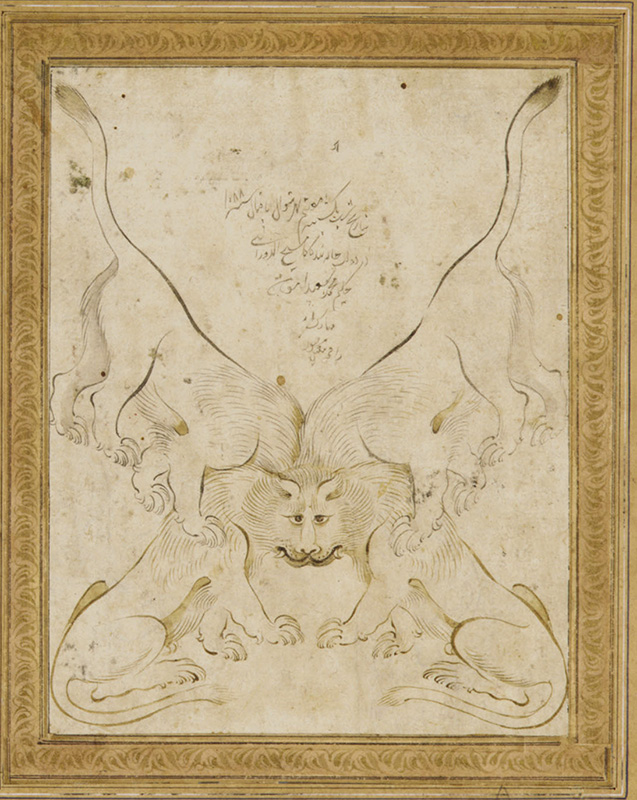Moʿin Moṣavver | Individual Drawings and Paintings
Drawinging 1677.1
Lion with Four Bodies and One Head
Location: Freer Gallery of Art and Arthur M. Sackler Gallery, Smithsonian Institution, Washington D.C.: The Art and History Collection, LTS2003.1.43 ((Detail: page cropped));
formerly in the Binney and Demotte Collections.
Drawing: Ink and light color on paper. 15.5 x 12.0 cm wide. Page: 31 x 23 cm.
Signature: Signed and dated 1088/1677.
Inscription
At the top center, reads: betāriḵ-e šab-e yek šanba haftom-e šahr-e šavvāl ba eqbāl sana 1088 dar dowlatḵāna banda bā mahi˙ al-dowrāni ḥakim moḥammad saʿidā. mobārak bād. raqam-e moʿin-e moṣavver.
Translation: “On the evening of Sunday, the seventh of the fortunate month of Shavvāl of the year 1088/2 December 1677, in the home of the "Jesus of the age", Dr. Mohammad Saʿida. May he be blessed. Drawn by Moʿin Moṣavver.” The date was actually a Friday, not a Sunday. The inscription is in Moʿin’s handwriting.
Description:
The bodies of four lions are quite calligraphically depicted radiating outward, like spokes in a wheel, from a central point on the page, where all four bodies are merged into a single, common head. There is no background or other elements in the drawing.
Bibliography:
Martin, MMP_1912, I, p.125, and II, pl.164.
Kühnel, Survey,_1939, p.1893.
Stchoukine, SA_1964, p.68.
Welch, SA_1973, no.77 (ill.).
Robinson, Colnaghi_1976, no.57 (ill.)
Soudovar, PC_1992, p.291 no.117 (ill.)
Commentary:
This excellent calligraphic drawing, in which the bodies of four lions are zoomorphically merged into a single head, is a variant on an illusionistic theme that occurs time and again in Persian painting. The four horse jokesheet in the Sarre Album (cf. Sarre-Mittwoch, ZRA_1914, pl.11) is another example of such illusionistic themes dating from a decade earlier, in which horses are used as the subject instead of lions. The drawing reveals both Moʿin’s keen sense of wit, and his deep interest in animals, particularly lions, which occur quite regularly in his art (cf. 1672.1, 1672.2, 1676.1, 1692.1). The signed and dated inscription in the artist’s own hand confirms the attribution, which can be considered secure.
Photo courtesy of Freer Gallery of Art and Arthur M. Sackler Gallery, Smithsonian Institution, Washington D.C.
Robert Eng
Last Updated: April 28, 2018 | Originally published: April 28, 2018
Drawinging 1677.1
Lion with Four Bodies and One Head
Location: Freer Gallery of Art and Arthur M. Sackler Gallery, Smithsonian Institution, Washington D.C.: The Art and History Collection, LTS2003.1.43 ((Detail: page cropped));
formerly in the Binney and Demotte Collections.
Drawing: Ink and light color on paper. 15.5 x 12.0 cm wide. Page: 31 x 23 cm.
Signature: Signed and dated 1088/1677.
Inscription
At the top center, reads: betāriḵ-e šab-e yek šanba haftom-e šahr-e šavvāl ba eqbāl sana 1088 dar dowlatḵāna banda bā mahi˙ al-dowrāni ḥakim moḥammad saʿidā. mobārak bād. raqam-e moʿin-e moṣavver.
Translation: “On the evening of Sunday, the seventh of the fortunate month of Shavvāl of the year 1088/2 December 1677, in the home of the "Jesus of the age", Dr. Mohammad Saʿida. May he be blessed. Drawn by Moʿin Moṣavver.” The date was actually a Friday, not a Sunday. The inscription is in Moʿin’s handwriting.
Description:
The bodies of four lions are quite calligraphically depicted radiating outward, like spokes in a wheel, from a central point on the page, where all four bodies are merged into a single, common head. There is no background or other elements in the drawing.
Bibliography:
Martin, MMP_1912, I, p.125, and II, pl.164.
Kühnel, Survey,_1939, p.1893.
Stchoukine, SA_1964, p.68.
Welch, SA_1973, no.77 (ill.).
Robinson, Colnaghi_1976, no.57 (ill.)
Soudovar, PC_1992, p.291 no.117 (ill.)
Commentary:
This excellent calligraphic drawing, in which the bodies of four lions are zoomorphically merged into a single head, is a variant on an illusionistic theme that occurs time and again in Persian painting. The four horse jokesheet in the Sarre Album (cf. Sarre-Mittwoch, ZRA_1914, pl.11) is another example of such illusionistic themes dating from a decade earlier, in which horses are used as the subject instead of lions. The drawing reveals both Moʿin’s keen sense of wit, and his deep interest in animals, particularly lions, which occur quite regularly in his art (cf. 1672.1, 1672.2, 1676.1, 1692.1). The signed and dated inscription in the artist’s own hand confirms the attribution, which can be considered secure.
Photo courtesy of Freer Gallery of Art and Arthur M. Sackler Gallery, Smithsonian Institution, Washington D.C.
Robert Eng
Last Updated: April 28, 2018 | Originally published: April 28, 2018
